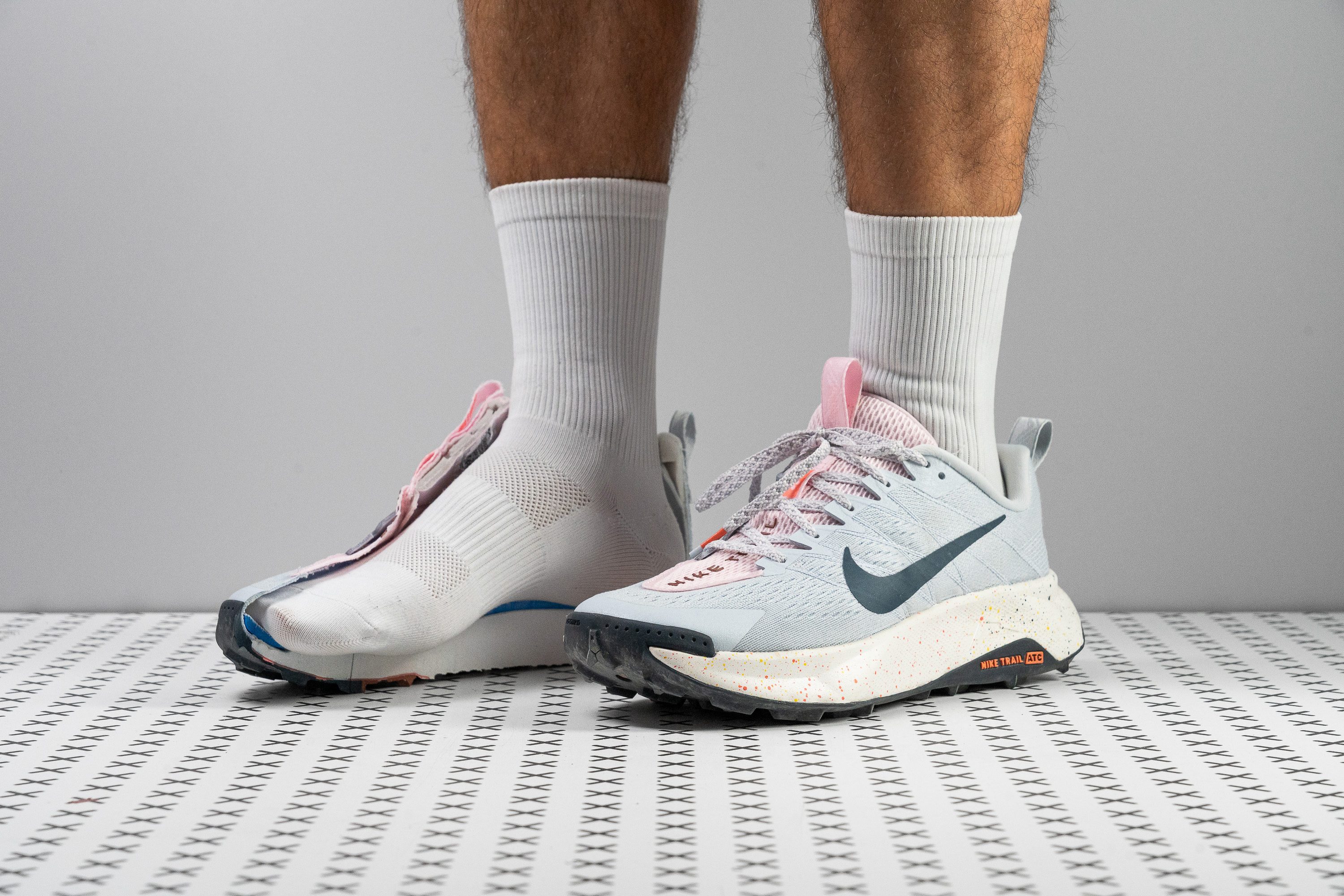Our verdict
- Top pick in best Nike trail running shoes
- Top pick in best running shoes for hiking
Pros
- Cushion-packed midsole
- Modernized upper
- Ideal for heel strikers
- Better build quality
- Bold new look with better finish
- Versatile
- Improved energy return
- Forefoot rock plate
Cons
- Still too heavy
- Mesh upper is fragile
- Brutal price hike
- Less agile than predecessors
Audience verdict
- Top 5% in trail running shoes
- Top 10% in Nike running shoes
Comparison
The most similar running shoes compared
+ + Add a shoe | |||||
|---|---|---|---|---|---|
| Audience score | 91 Superb! | 85 Good! | 90 Superb! | 89 Great! | |
| Price | $165 | $170 | $150 | $150 | |
| Trail terrain | LightModerate | Light | Light | LightModerate | |
| Shock absorption | High | Moderate | - | Moderate | |
| Energy return | Moderate | Moderate | - | Moderate | |
| Traction | - | High | - | High | |
| Arch support | Neutral | Neutral | Neutral | Neutral | |
| Weight lab Weight brand | 11 oz / 312g 11 oz / 311g | 11 oz / 312g 10.9 oz / 309g | 9.7 oz / 275g 10.8 oz / 307g | 10.9 oz / 309g 10.9 oz / 309g | |
| Drop lab Drop brand | 10.9 mm 9.5 mm | 6.5 mm 6.0 mm | 11.6 mm 6.0 mm | 8.8 mm 6.0 mm | |
| Strike pattern | Heel | Mid/forefoot | Heel | HeelMid/forefoot | |
| Size | True to size | - | True to size | True to size | |
| Midsole softness | Soft | Soft | Balanced | Soft | |
| Difference in midsole softness in cold | Normal | Normal | Normal | Big | |
| Plate | Rock plate | ✗ | ✗ | ✗ | |
| Toebox durability | Very bad | Decent | Good | Bad | |
| Heel padding durability | Good | Bad | Good | Good | |
| Outsole durability | Decent | Decent | Good | Decent | |
| Breathability | Moderate | Moderate | Warm | Moderate | |
| Width / fit | Medium | Medium | Medium | Medium | |
| Toebox width | Medium | Medium | Medium | Medium | |
| Stiffness | Moderate | Moderate | Moderate | Moderate | |
| Torsional rigidity | Moderate | Stiff | Stiff | Stiff | |
| Heel counter stiffness | Moderate | Stiff | Stiff | Stiff | |
| Lug depth | 3.4 mm | 3.5 mm | 3.3 mm | 3.6 mm | |
| Heel stack lab Heel stack brand | 38.3 mm 38.0 mm | 37.6 mm 36.0 mm | 35.8 mm 30.0 mm | 36.7 mm 39.0 mm | |
| Forefoot lab Forefoot brand | 27.4 mm 28.5 mm | 31.1 mm 30.0 mm | 24.2 mm 24.0 mm | 27.9 mm 33.0 mm | |
| Widths available | Normal | Normal | Normal | Normal | |
| Season | All seasons | All seasons | All seasons | All seasons | |
| Removable insole | ✓ | ✓ | ✓ | ✓ | |
| Orthotic friendly | ✓ | ✓ | ✓ | ✓ | |
| Ranking | #35 Top 10% | #200 Bottom 46% | #48 Top 13% | #88 Top 24% | |
| Popularity | #136 Top 37% | #186 Top 50% | #223 Bottom 40% | #173 Top 47% |
Who should buy
After testing the Wildhorse 10 in the lab, we found it’s a solid choice for:
- Those who liked previous Wildhorse models but wanted modern materials and extra cushioning. Nike delivers exactly that here.
- Trail runners looking for a do-it-all shoe suited for easy to moderate terrain, complete with a forefoot rock plate.
- Heel strikers who need strong shock absorption and want a shoe that can handle trail runs, travel, or even casual daily wear.
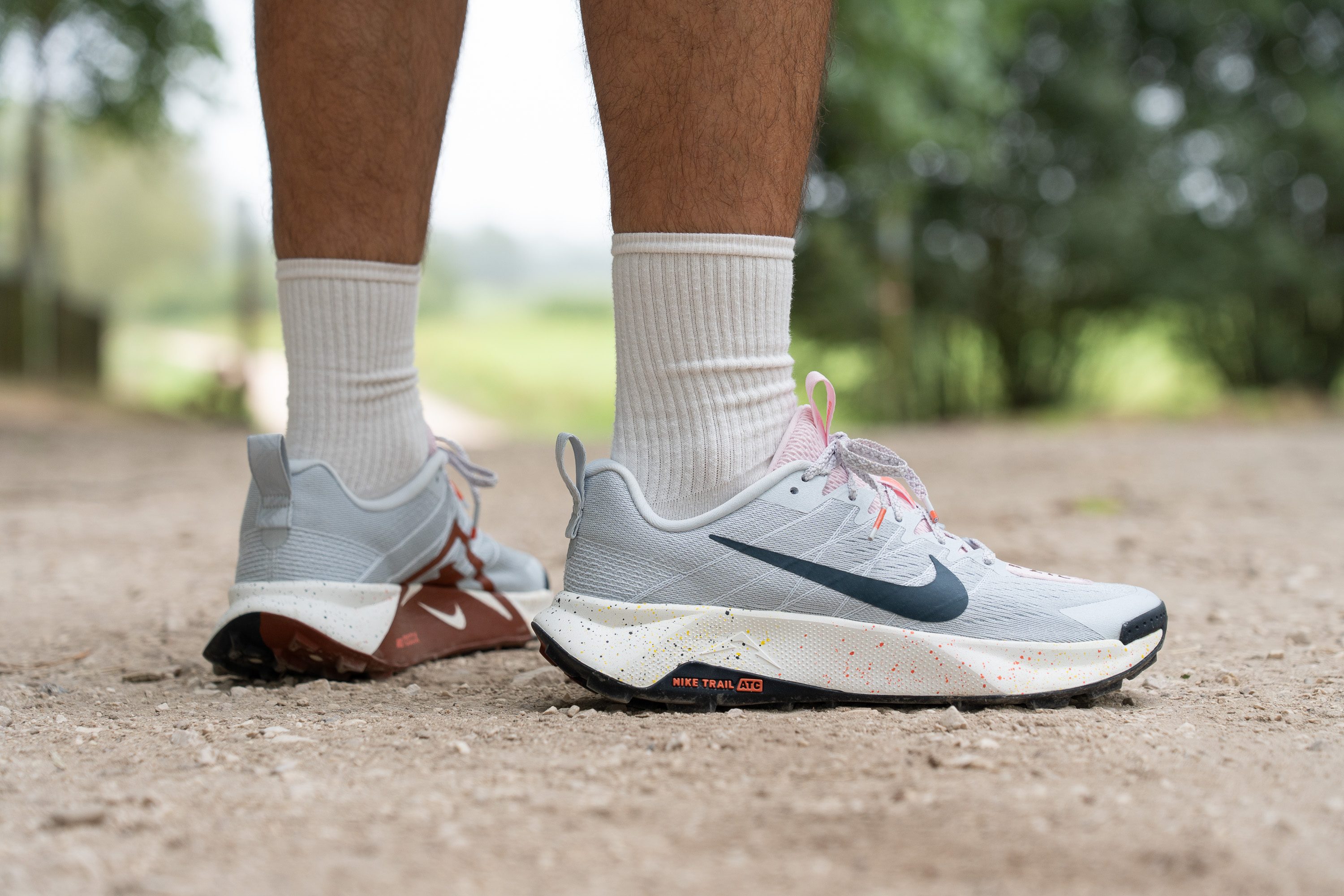
Who should NOT buy
We think the Wildhorse 10 isn’t the best choice if budget is a concern. Its price jump over the previous version feels steep, especially when you can get more wallet-friendly trail shoes like the Merrell Nova 3 or the Nike Juniper Trail 3.
We’re also convinced that the upper may not hold up for trail runners who usually wear through shoes fast, as we discovered its engineered mesh lacks long-term toughness. For a more rugged-and-ready design, we recommend the Nike Zegama 2 or the Merrell Agility Peak 5.

Cushioning
Shock absorption
The Wildhorse 10 brings a major shift to the series... so much so that Nike skipped version 9 entirely, which was rumored to be a minor refresh, and jumped straight to 10 in a single leap. That’s why we weren’t surprised to discover outstanding shock absorption in the heel, recording an impressive 144 SA.
In contrast, the forefoot stayed closer to average at 105 SA, delivering a more grounded sensation up front.
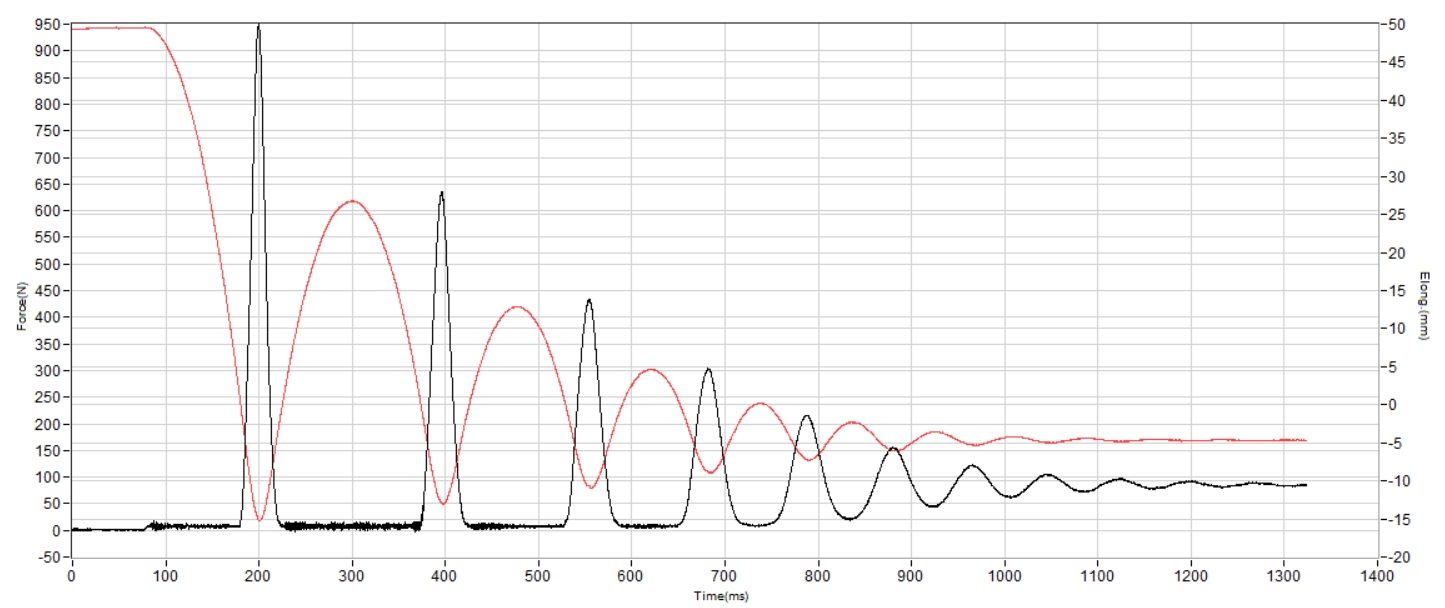
| Wildhorse 10 | 144 SA |
| Average | 122 SA |
Energy return
Switching from React to ReactX delivers a clear advantage: more energy return. We measured 61.3%, a solid jump from the previous 54.7%, making the ride noticeably more responsive underfoot.
| Wildhorse 10 | 61.3% |
| Average | 55.6% |
Heel stack
Nike also added more foam under the heel, topping the Wildhorse 10 with 38.3 mm of cushioning.
That caught us a bit off guard, as this shoe was never part of the max-stack club, but now it's edging into that zone. Those who enjoyed the Wildhorse 8 won't feel a dramatic shift as it already had 34.2 mm, but we discovered that the difference is clearly noticeable while running.
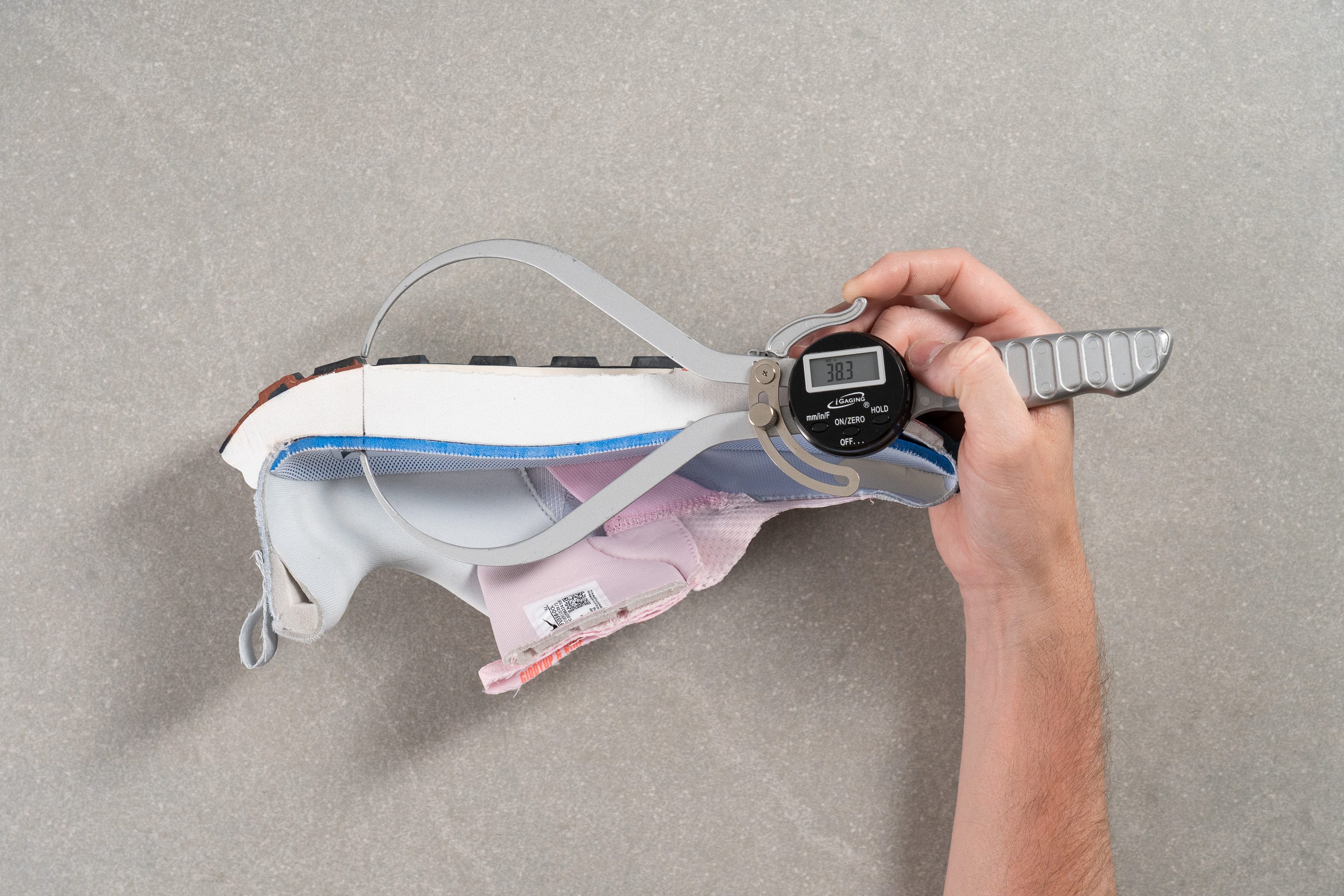
| Wildhorse 10 | 38.3 mm |
| Average | 32.6 mm |
Forefoot stack
The heel also gets a small boost, reaching 27.4 mm. This makes it more suited than the previous model for long-distance running and even the occasional ultra if you're looking for a do-it-all trail shoe.
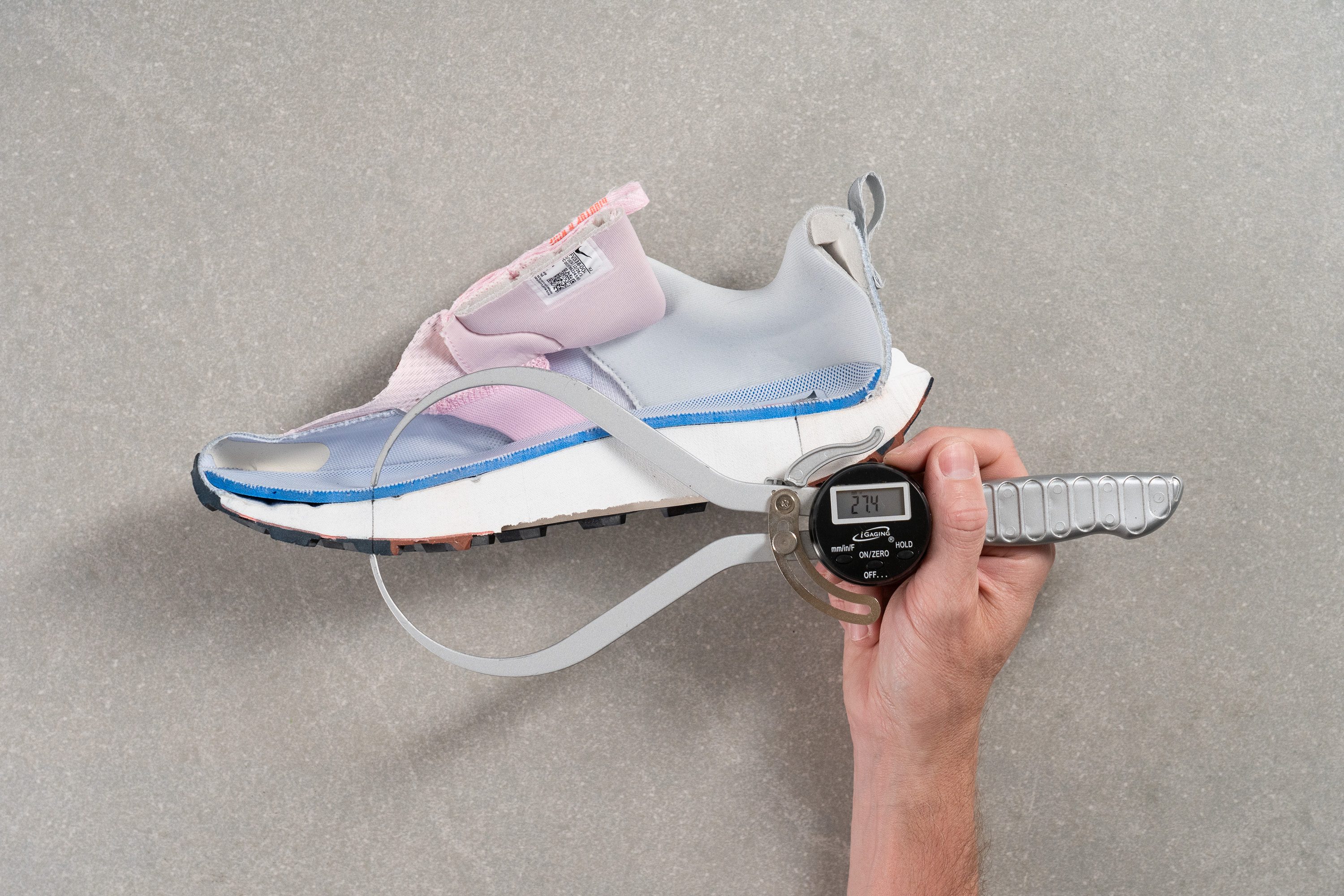
| Wildhorse 10 | 27.4 mm |
| Average | 25.1 mm |
Drop
The difference between these two measurements gives us a high-drop setup of 10.9 mm. This isn’t unusual for Nike, as most of their shoes come with a big offset, and it clearly favors heel strikers thanks to the thick and pillowy foam in the rear.
What about midfoot and forefoot strikers? It works well enough, but you need to be comfortable with a shoe that feels slightly steep and less natural, as shown in the sliced shoe we pictured.
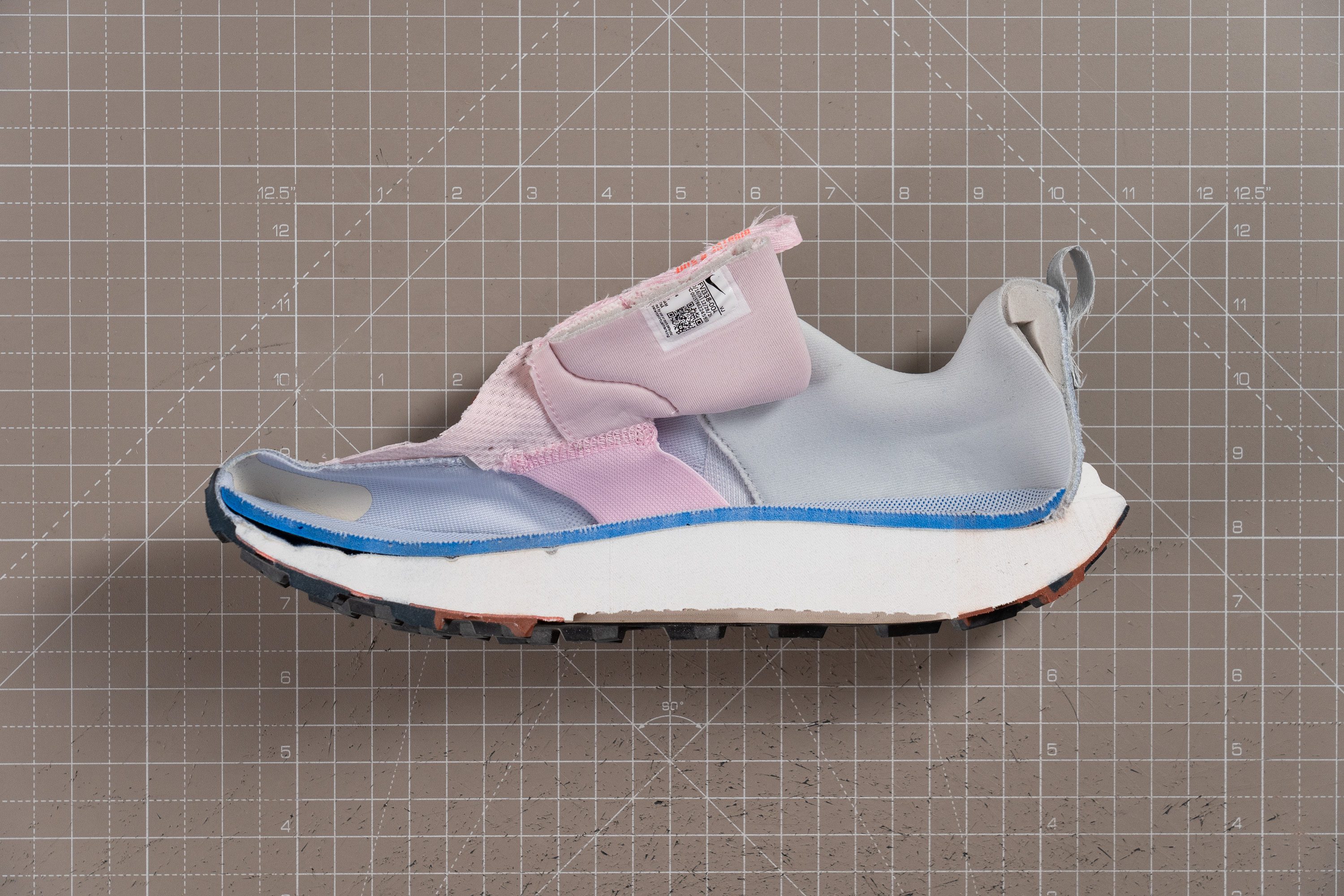
| Wildhorse 10 | 10.9 mm |
| Average | 7.5 mm |
Midsole softness
The new ReactX foam used in the Wildhorse 10 is softer than in any past version, now measuring 14.6 HA on our durometer.
That makes it a plush shoe by trail standards, and whether that’s good or bad depends entirely on what you like. Some trail runners lean toward firmer midsoles for a stable ride, while others prefer comfort-first setups with stronger shock absorption. Based on what we tested in the lab, the second group will enjoy this shoe much more.
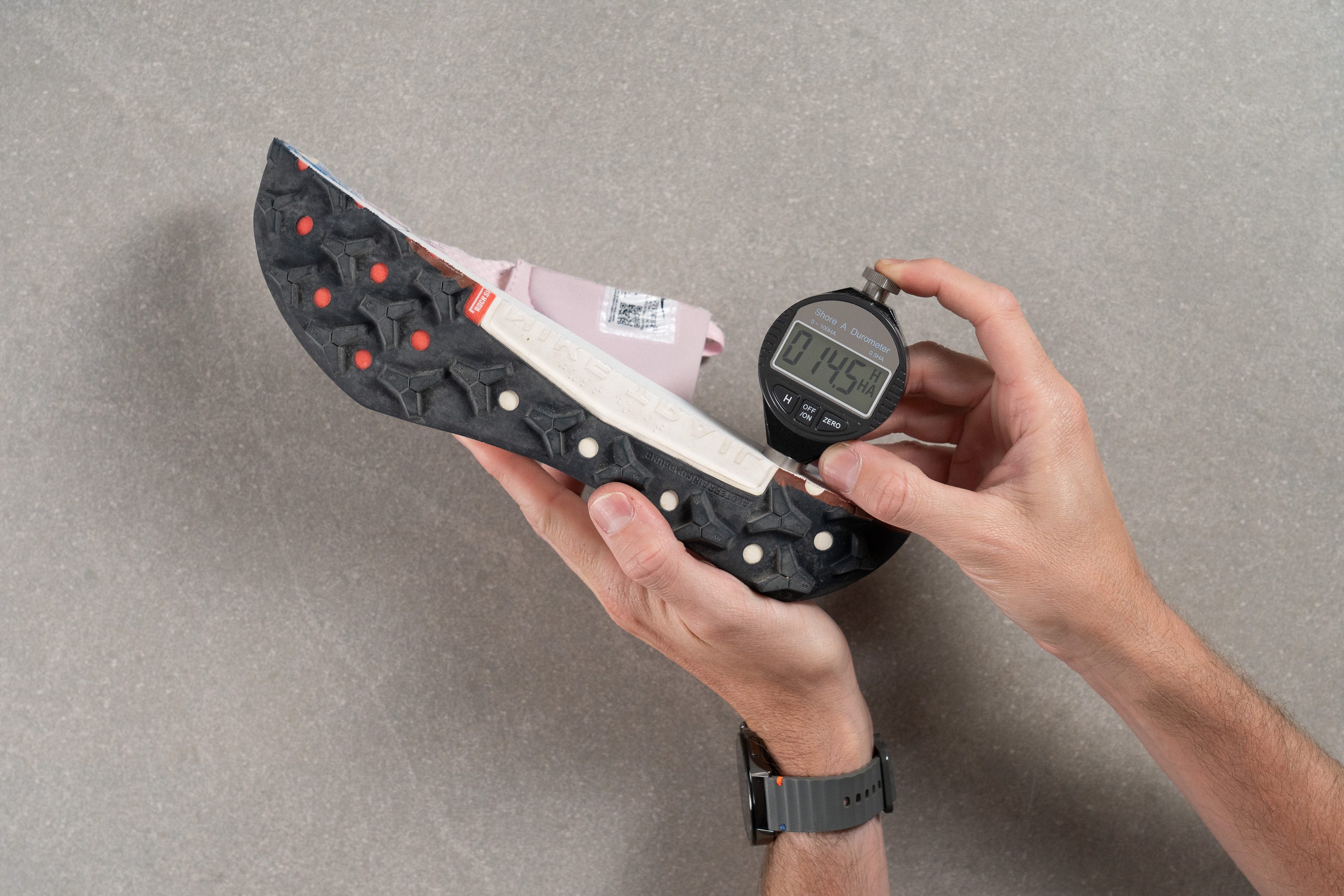
| Wildhorse 10 | 14.6 HA |
| Average | 21.9 HA |
Rocker
Adding more foam underfoot pushed Nike to increase the midsole curvature in both the heel and forefoot. This is easy to feel while running and makes the 10th edition the most rocker-shaped Wildhorse so far!

Plate
One feature that sets the Wildhorse series apart from other Nike trail shoes is the rock plate, which remains in the forefoot. Nike calls it the "Rock Shield" and seems like a legit name.

Size and fit
Size
Nike Wildhorse 10 fits true to size (24 votes).
Width / Fit
We tested the gel mold after letting it firm up in the freezer and found that the widest section measured 96.9 mm.
That places it within the average range. It's not narrow, but not super-wide either, though we still had more zones to explore before finishing our full fit check.
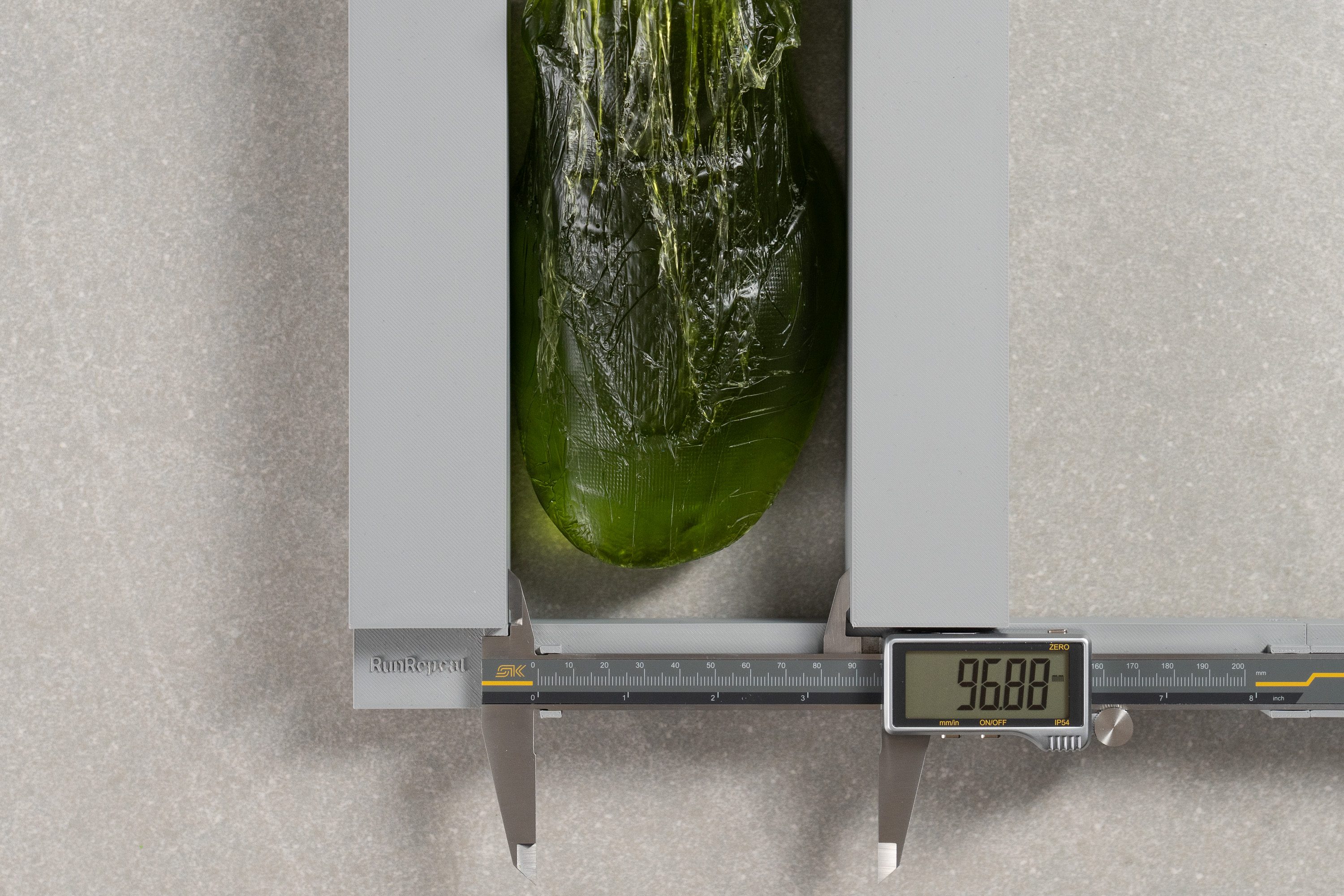
| Wildhorse 10 | 96.9 mm |
| Average | 95.7 mm |
Toebox width
We also measured the toebox and got 75.4 mm. That points to an average fit, which clearly matched what we felt during our on-foot testing. Those with extreme foot shapes won't get a perfect fit, but Nike tried to please as many runners as they could here.
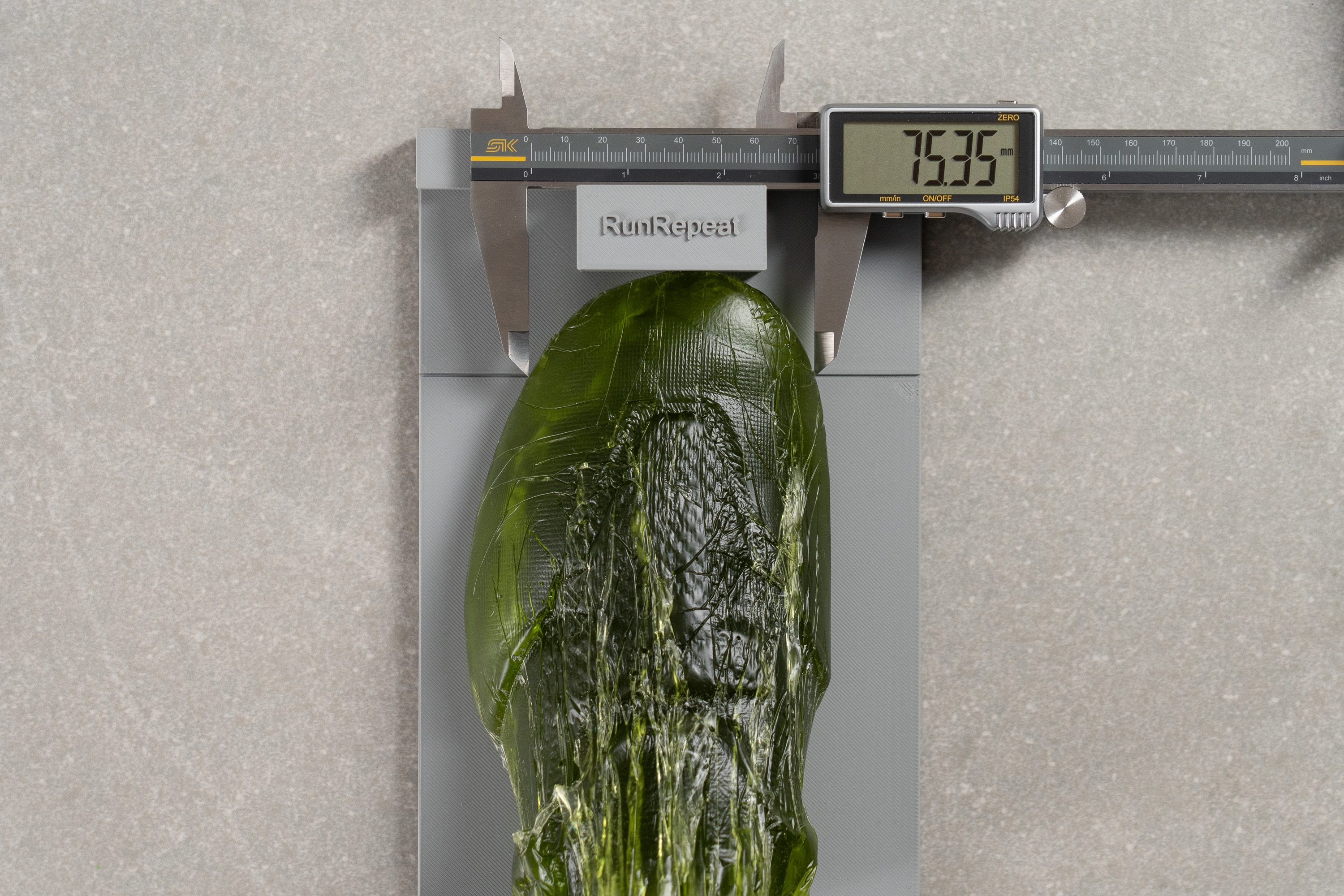
| Wildhorse 10 | 75.4 mm |
| Average | 74.7 mm |
Toebox height
Unsurprisingly, the toebox height felt just right. It was not restrictive, yet supportive enough so the toes doesn't move around too much.
We grabbed the calipers for a third check and measured 28.0 mm, confirming what we found earlier: Nike played it safe with a zero-risk design.
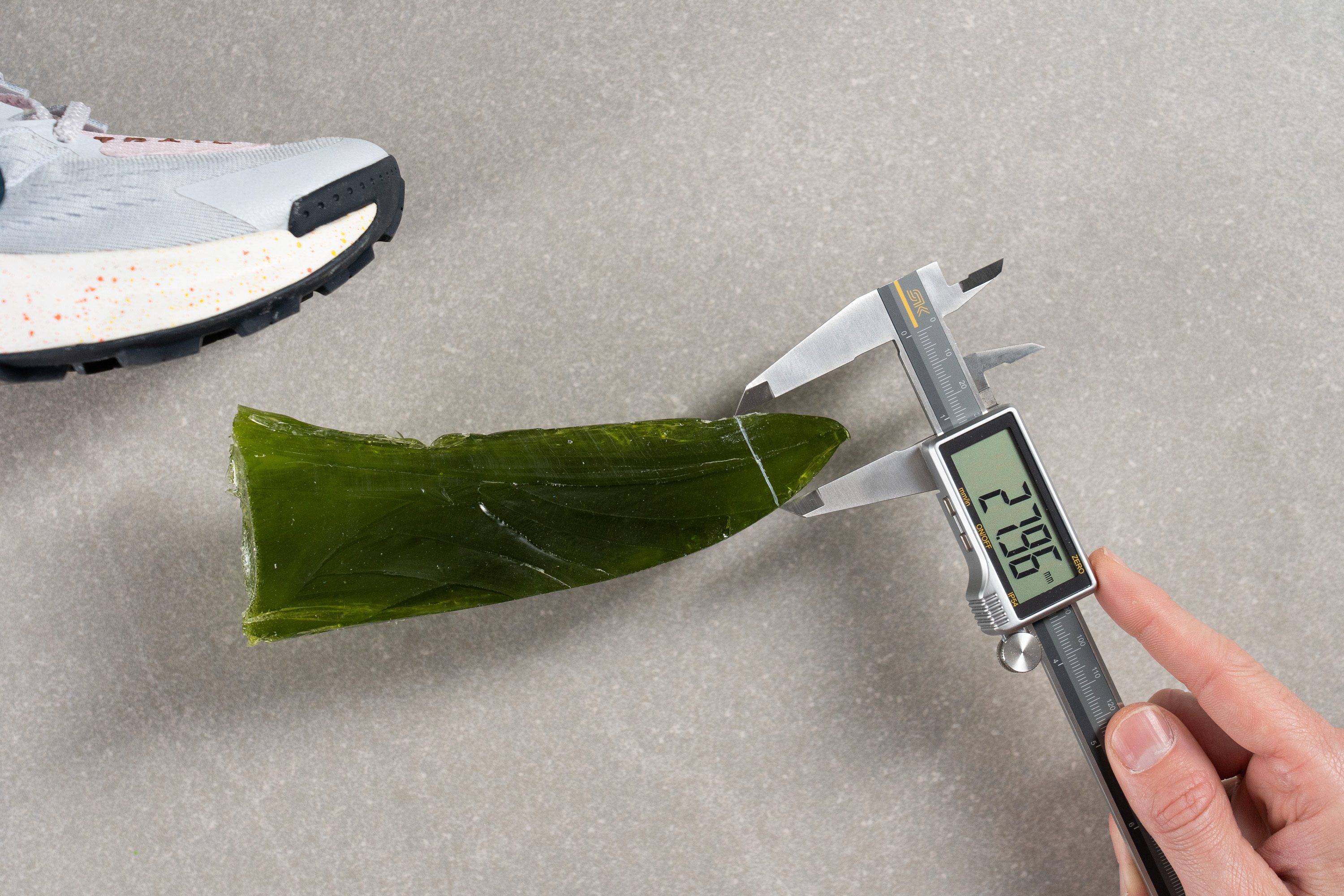
| Wildhorse 10 | 28.0 mm |
| Average | 27.1 mm |
Traction / Grip
Lug depth
We measured the lugs and found just 3.4 mm, which puts them on the shallow side. That setup works well for light trails and door-to-trail runs, offering a smooth ride with just enough bite for moderate paths, plus it's not too uncomfortable for the occasional road section.
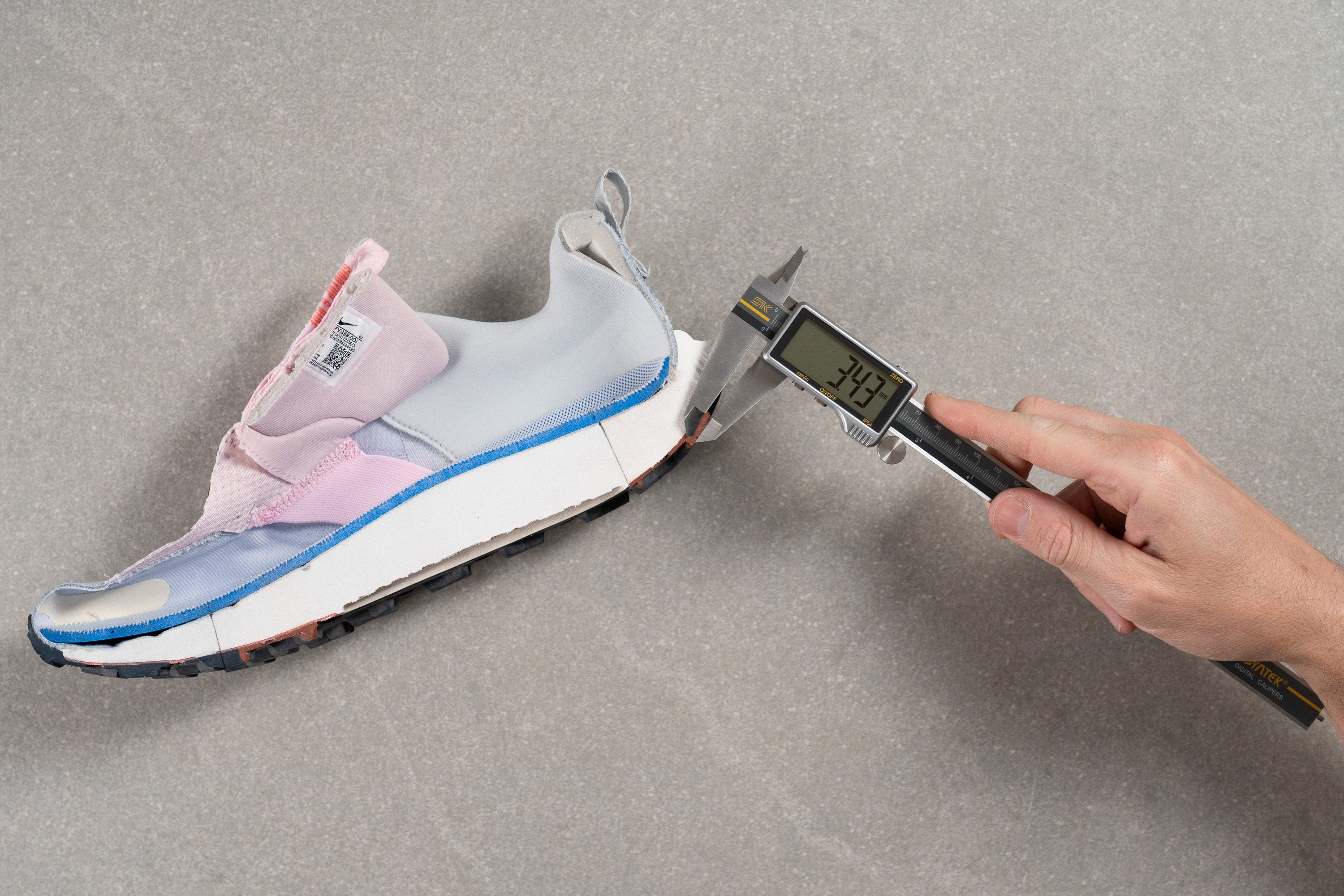
| Wildhorse 10 | 3.4 mm |
| Average | 3.5 mm |
Outsole design
The outsole of the Wildhorse 10 uses Nike’s All Terrain Compound (ATC) rubber, split into two zones with a central exposed foam channel running from heel to midfoot to cut some weight.
The heel and forefoot feature Y-shaped lugs arranged in alternating directions. These lugs are made from thick molded rubber and vary slightly in orientation depending on placement.
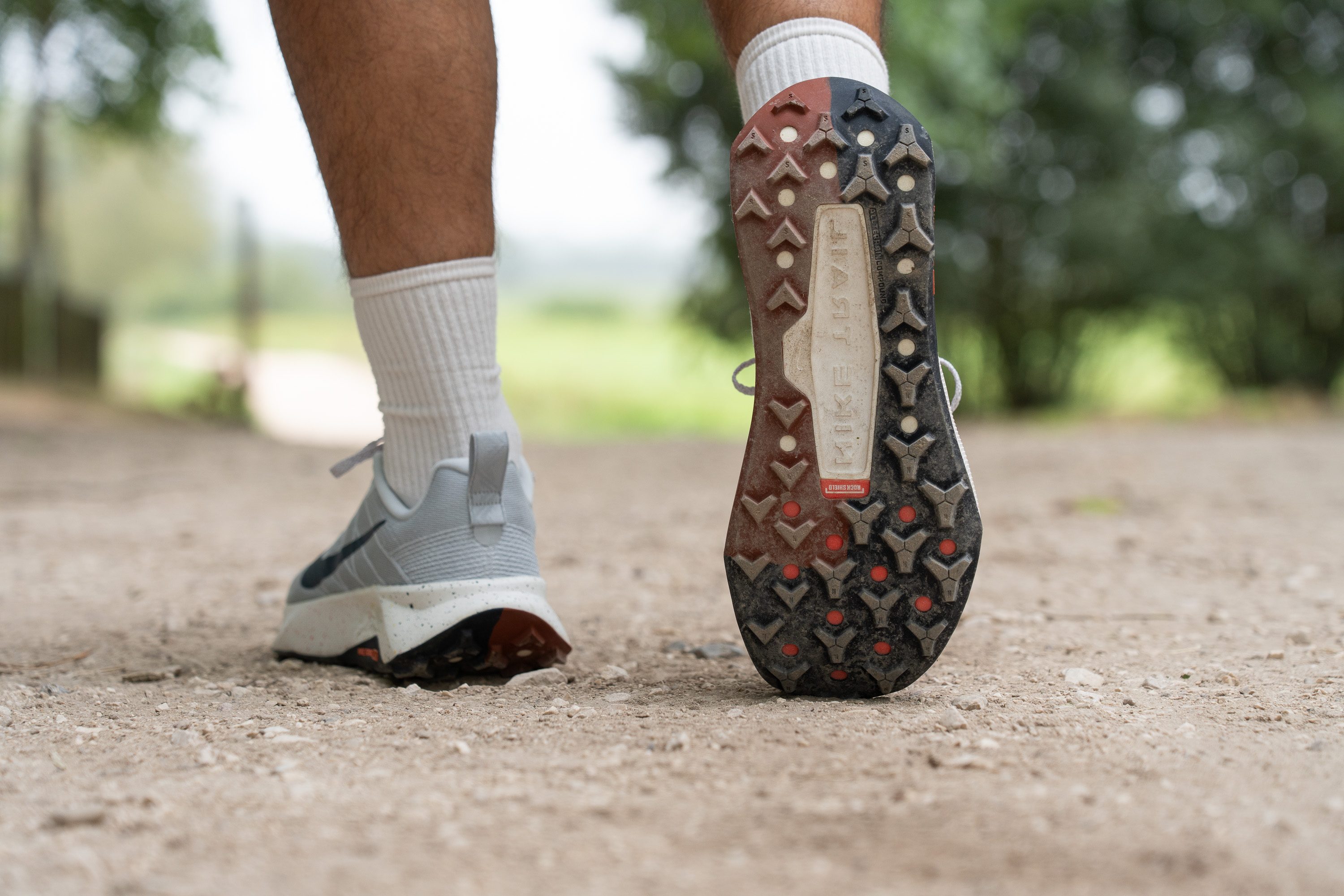
Flexibility / Stiffness
It came as no surprise in the lab that the Wildhorse 10 turned out stiffer than previous versions, reaching 15.0N in our 30-degree bend test. The reason is simple: the increased stack height adds more material underfoot, which naturally boosts stiffness.
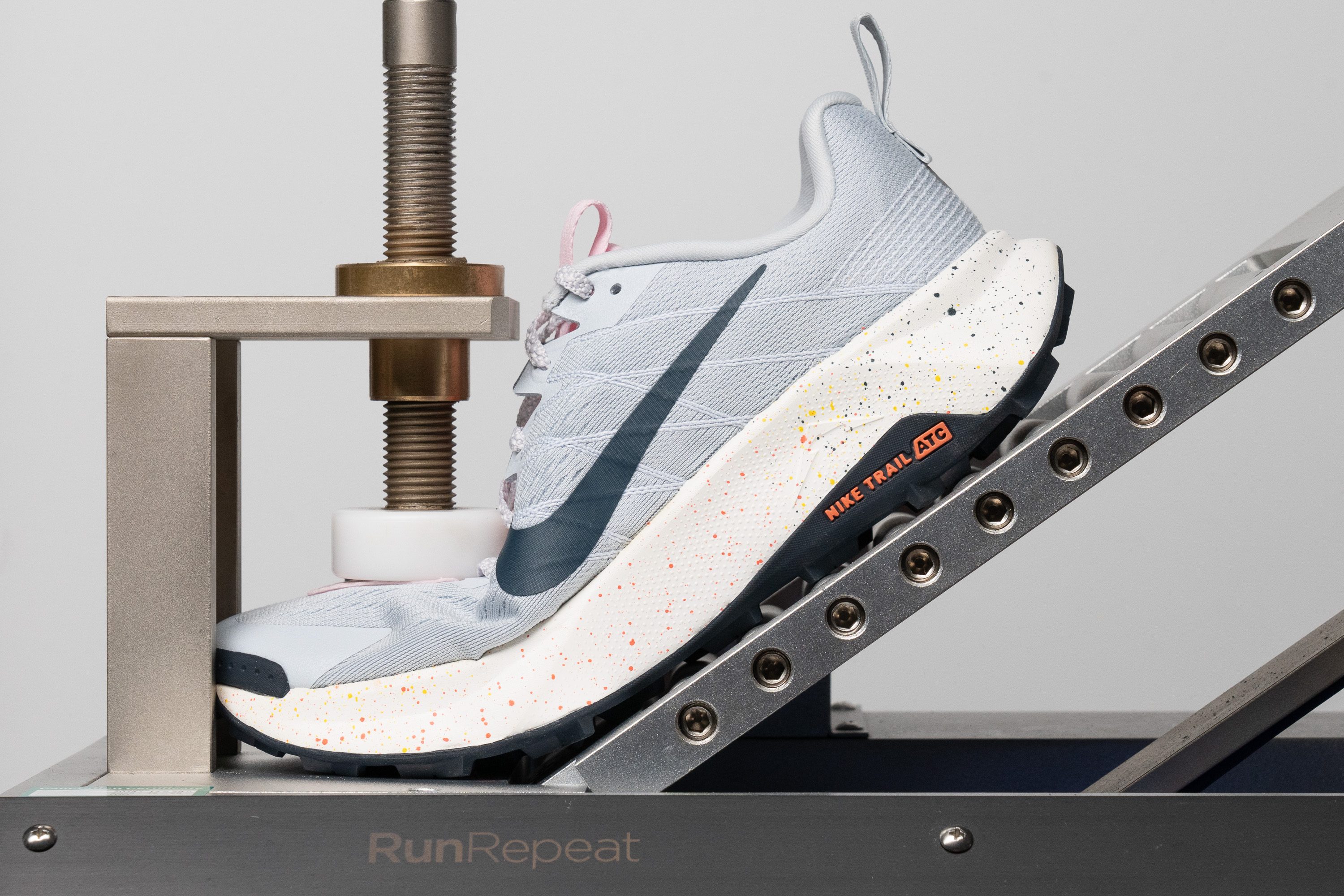
| Wildhorse 10 | 15.0N |
| Average | 14.6N |
Weight
The Wildhorse 10 remains a heavy running shoe at 11.0 oz or 312g. In our view, weight continues to be one of the shoe’s weakest points for yet another version.
That said, there’s a small upside. Nike raised the stack height in this model, yet it’s slightly lighter than its predecessor. So while we still see it as a drawback, it’s at least a step forward... if that makes sense.
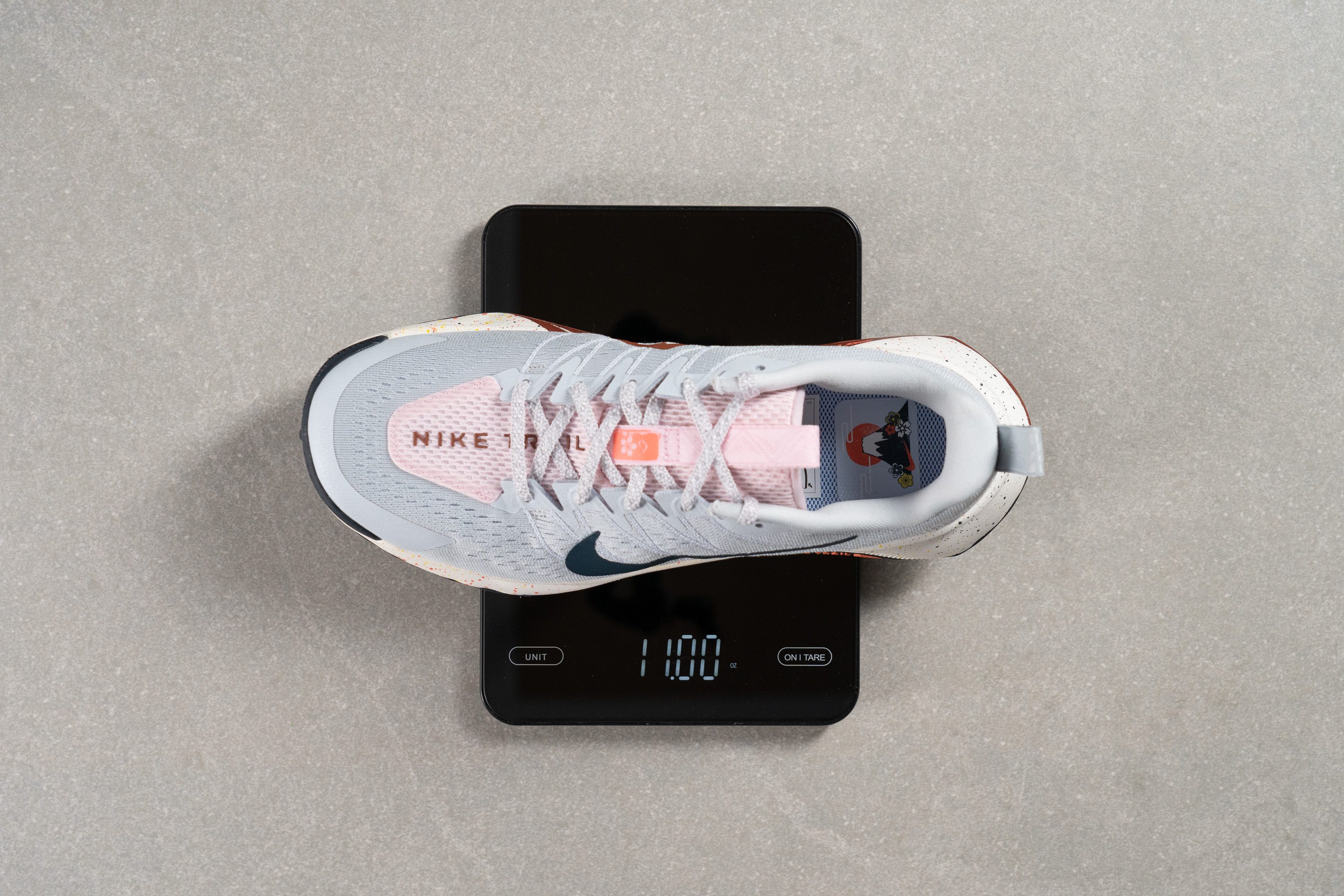
| Wildhorse 10 | 11.0 oz (312g) |
| Average | 10.2 oz (289g) |
Breathability
The upper of the Wildhorse 10 looks a lot like a road running shoe, only upgraded with trail-ready reinforcements. That might suggest good ventilation, but instead of guessing, we ran our lab tests to find out.
Using our smoke machine, we found airflow to be decent, but not outstanding. It earned a 3 out of 5 score, which is typical for trail models. Still, if you run in very hot climates, it might not be the ideal option.
Ventilation mainly happens through small punched holes in the upper. That raised some concerns about long-term durability, but we’ll evaluate that in a different test.
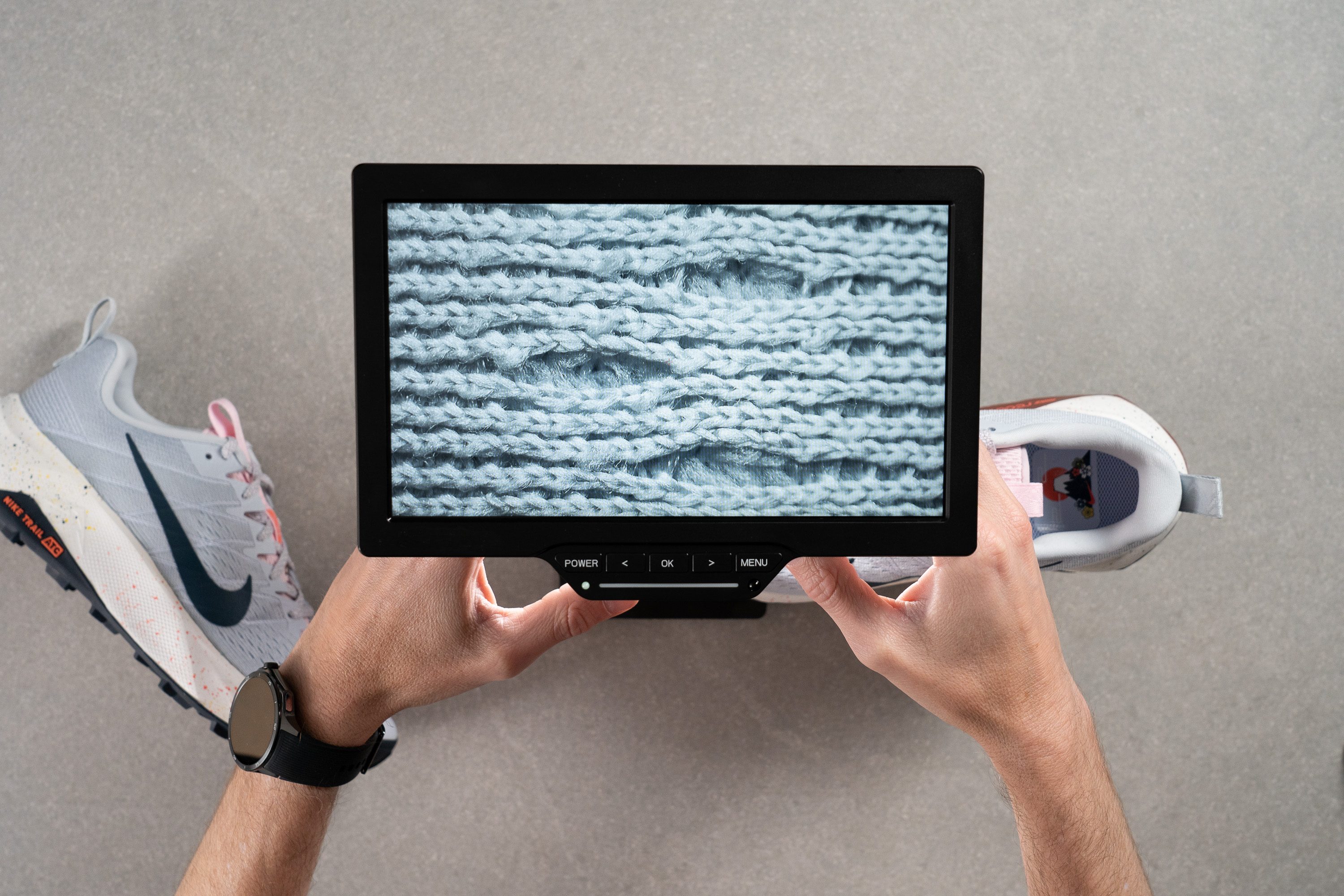
Under the microscope, we found a two-layer structure. The thinner layer, positioned closest to the foot, covers the holes and limits airflow. This explains the mid-range ventilation score.
Comfort and design are solid, with well-placed plastic reinforcements in the toe cap. Build quality has improved compared to previous versions, which makes sense given the higher price tag.
| Wildhorse 10 | 3 |
| Average | 3.2 |
Stability
Lateral stability test
The Wildhorse 10 is a good pick just for neutral runners, which makes sense given its higher stack height and plush foam. It's not a super unstable shoe per se, but it's not supportive enough to handle those who have strong lateral forces in their stride.
Torsional rigidity
Luckily, Nike kept it moderately flexible with a 3 out of 5 score in our torsional rigidity test. That’s a welcome decision, especially with so many trail shoes leaning toward an overly stiff ride that sometimes feels awkward on mountain terrain.
| Wildhorse 10 | 3 |
| Average | 3.6 |
Heel counter stiffness
The heel counter is quite similar to the one of a daily trainer like the Nike Vomero 18, with a balanced 3/5 score.
| Wildhorse 10 | 3 |
| Average | 3 |
Midsole width - forefoot
The biggest change in the Wildhorse 10 isn’t the foam or the outsole, but its size. This model used to run on the narrow side, but now it’s a maxed-out shoe with 120.6 mm in the forefoot. That’s a clear shift from the usual Wildhorse fit and might not sit well with longtime fans.
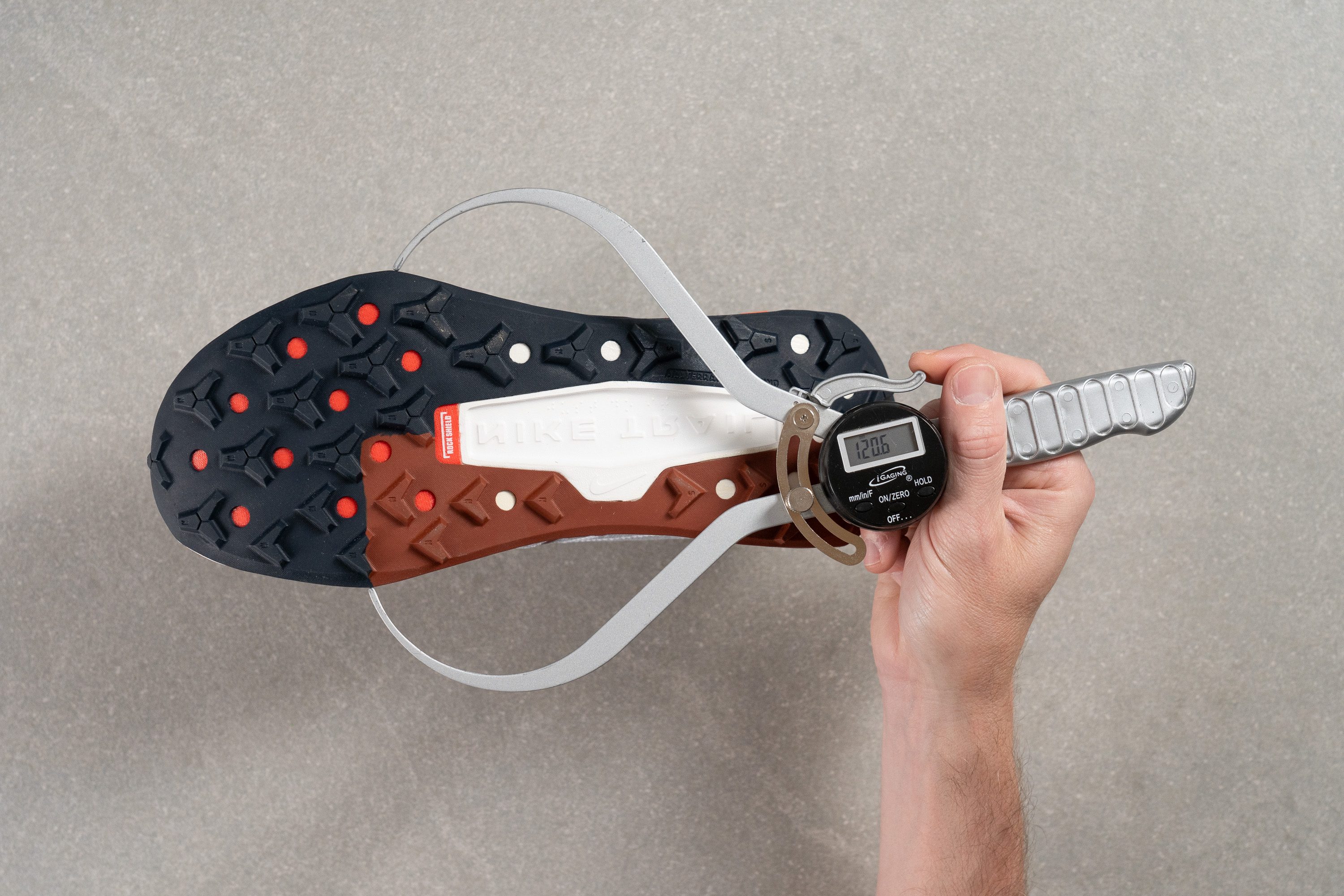
| Wildhorse 10 | 120.6 mm |
| Average | 112.8 mm |
Midsole width - heel
The heel also expanded, but to a more moderate extent. It measures slightly wider than average at 93.8 mm, aiming to improve stability in the rearfoot.
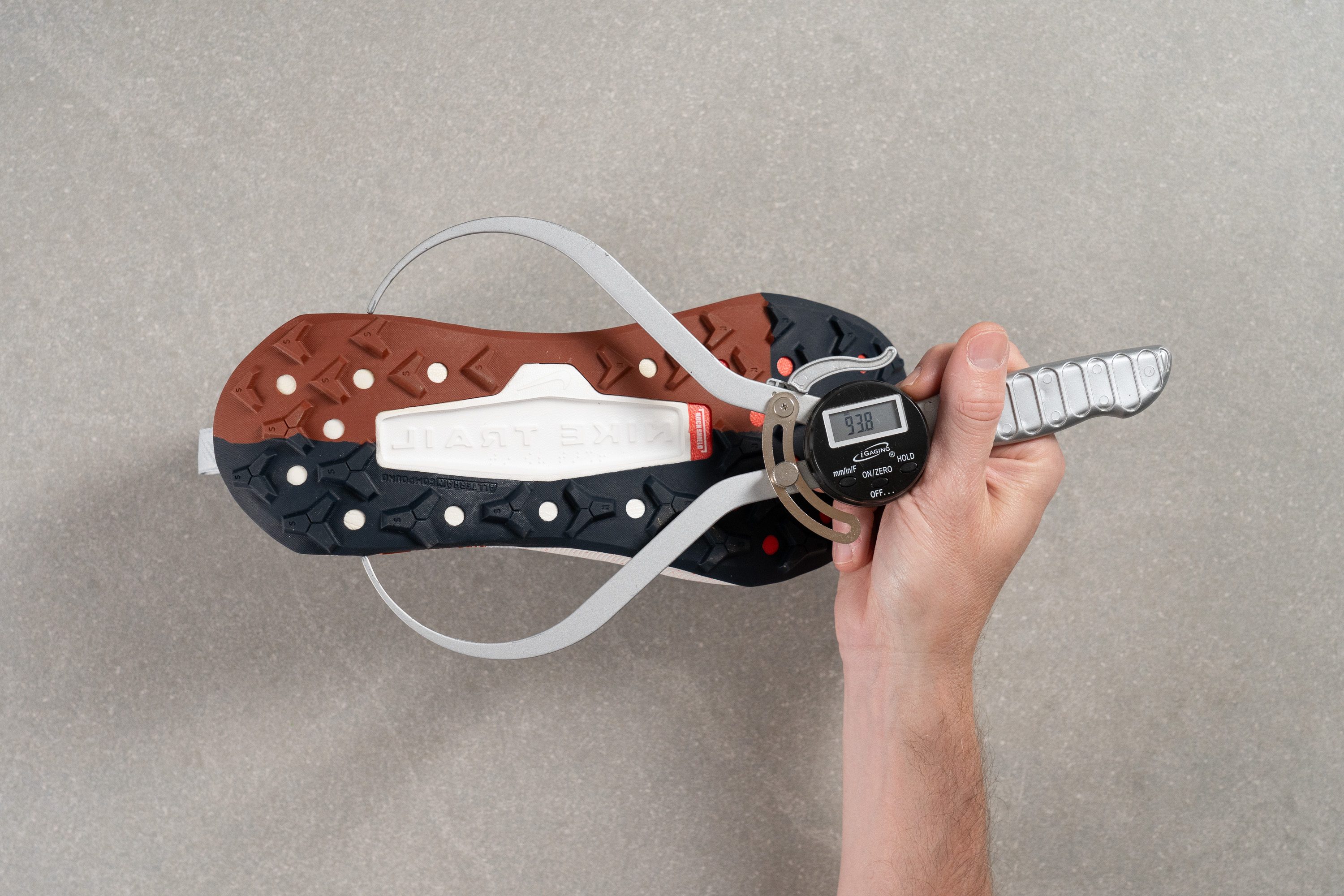
| Wildhorse 10 | 93.8 mm |
| Average | 89.9 mm |
Durability
Toebox durability
This is a key test for a trail shoe, as it helps us replicate how the upper handles abrasion. We found that the engineered mesh used by Nike isn't very durable, earning the lowest possible score of 1 out of 5.
| Wildhorse 10 | 1 |
| Average | 3.1 |
Heel padding durability
After a poor result, we moved on to test the heel padding, which performed much better with a perfect 5 out of 5. It seems the Wildhorse 10 is a shoe full of contrasts.
| Wildhorse 10 | 5 |
| Average | 3 |
Outsole durability
The durability of Nike’s new All Terrain Compound didn’t quite meet our expectations, showing 1.3 mm of wear. It’s not a dealbreaker and won’t matter for most runners, but if you’re tough on outsoles, you might want to think twice about this one.
| Wildhorse 10 | 1.3 mm |
| Average | 0.9 mm |
Outsole thickness
There’s also not much rubber beneath the foam with only 1.6 mm. We believe that Nike tried to cut some weight from an already heavy shoe.
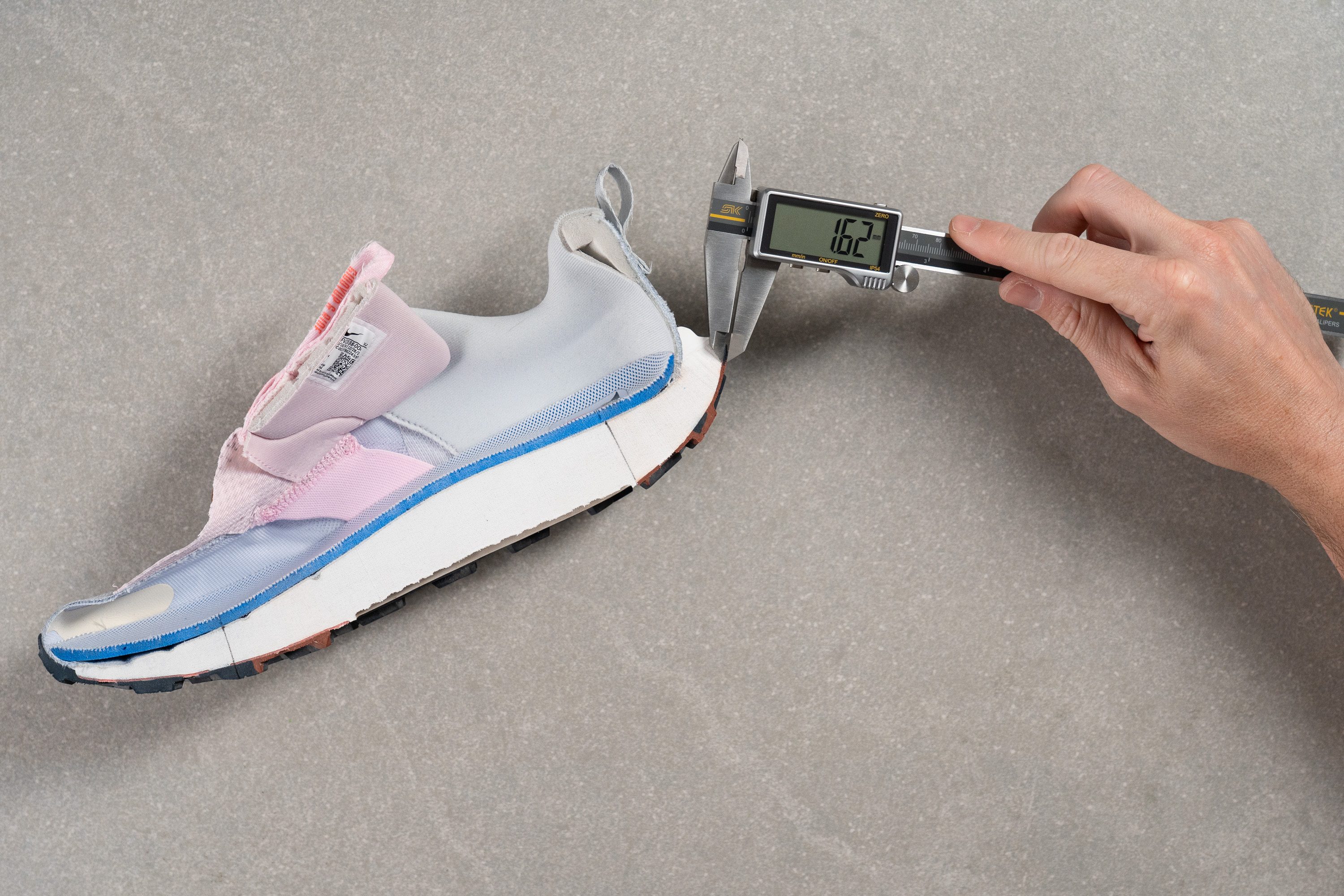
| Wildhorse 10 | 1.6 mm |
| Average | 2.2 mm |
Misc
Insole thickness
The insole measures 5.0 mm thick, which is right around average, and there’s nothing particularly notable to mention about it.
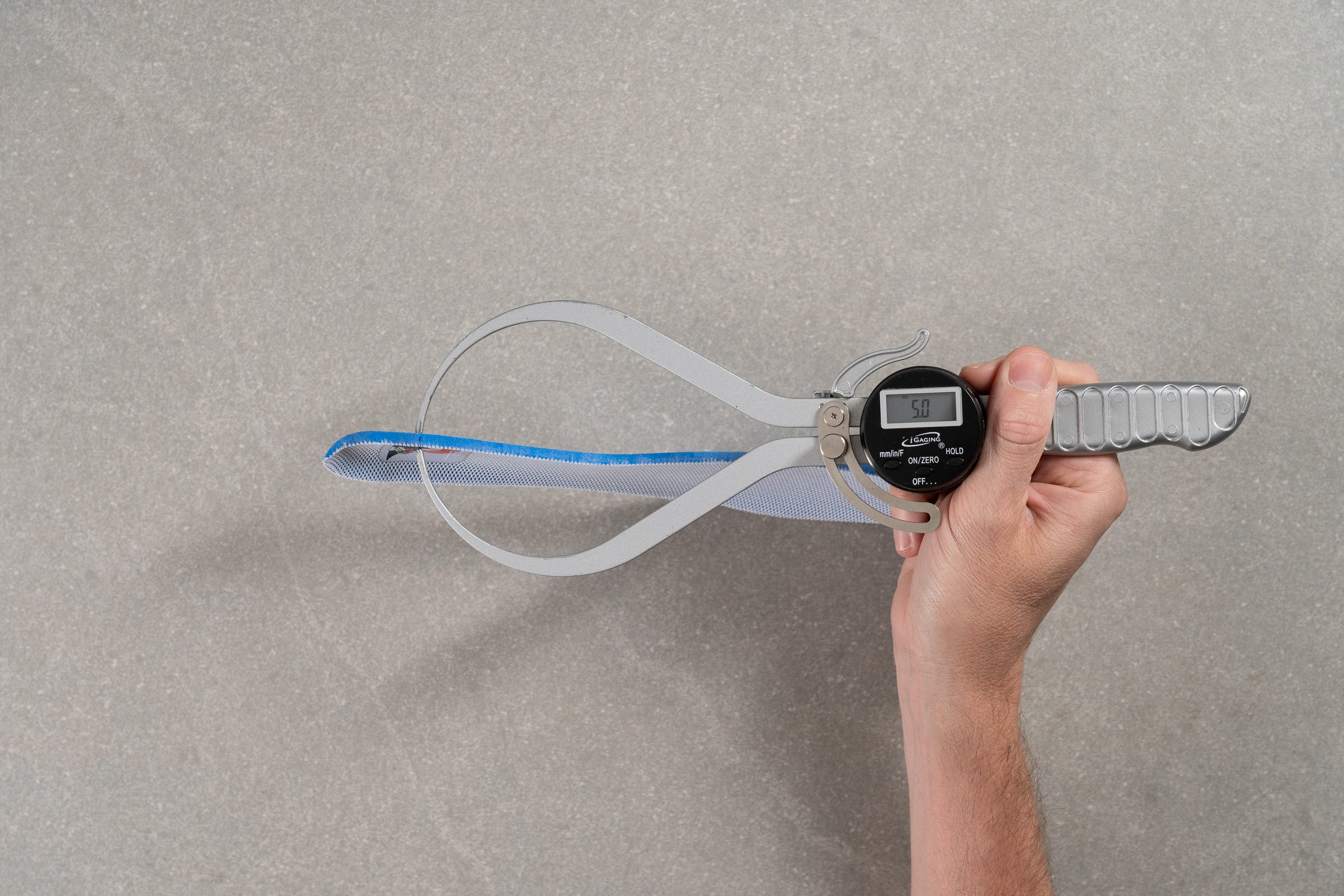
| Wildhorse 10 | 5.0 mm |
| Average | 4.7 mm |
Removable insole
The insole is removable, so you can swap it for your own if needed. However, you’ll miss out on the nice Fuji-inspired sticker that comes with it.
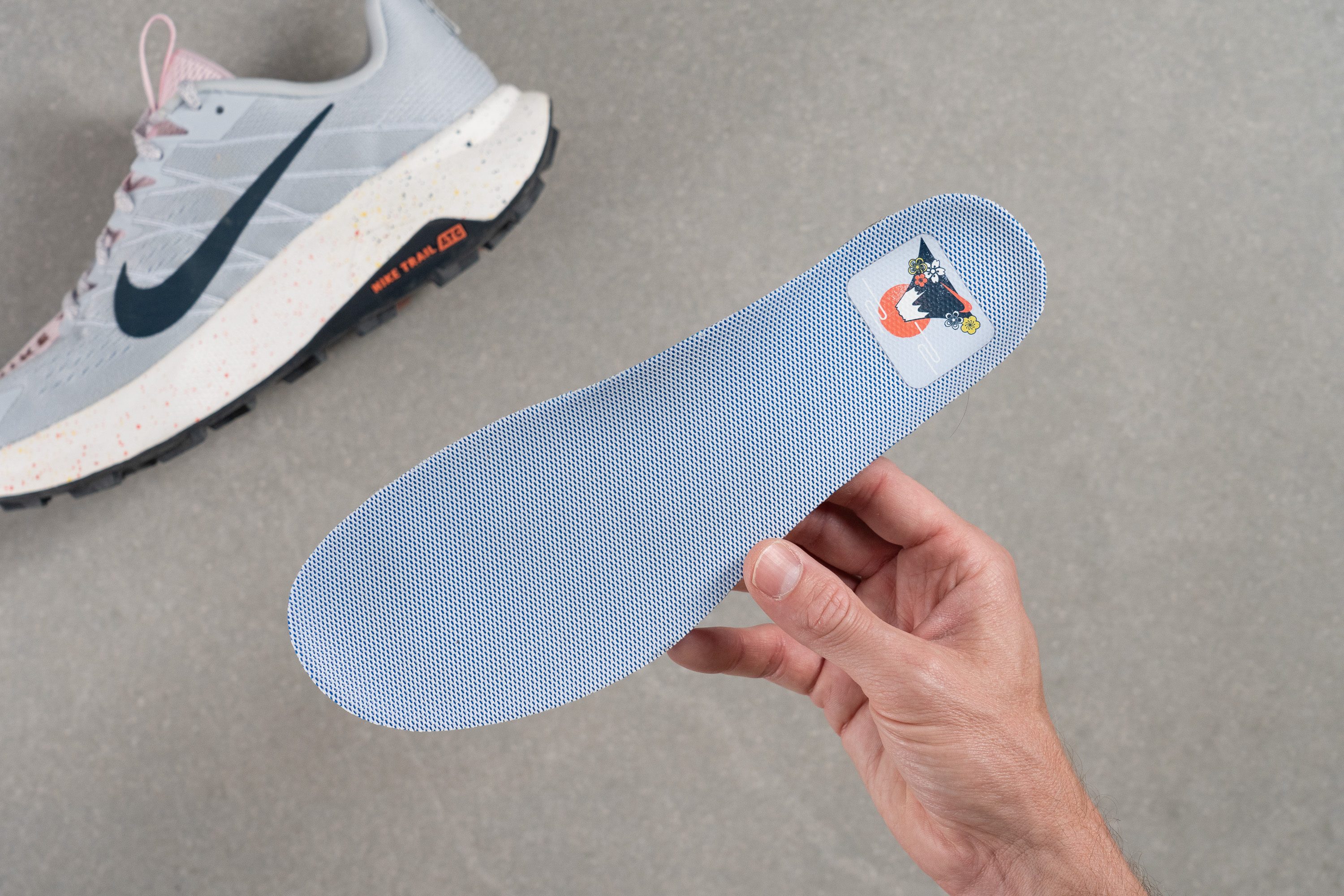
| Wildhorse 10 | Yes |
Midsole softness in cold (%)
ReactX didn’t handle cold well, becoming 36% firmer after just 20 minutes in our freezer. Not an ideal result for a modern foam.
| Wildhorse 10 | 36% |
| Average | 26% |
Reflective elements
The Wildhorse includes the same reflective elements seen on recent Nike trail models. They’re not flashy or decorative, but they get the job done.
| Wildhorse 10 | Yes |
Tongue padding
The fit of the Wildhorse 10 shows that Nike prioritized comfort over weight savings. We found an 8.3 mm tongue that's thick and plush, though it likely adds more weight than necessary and could benefit from a slimmer design.
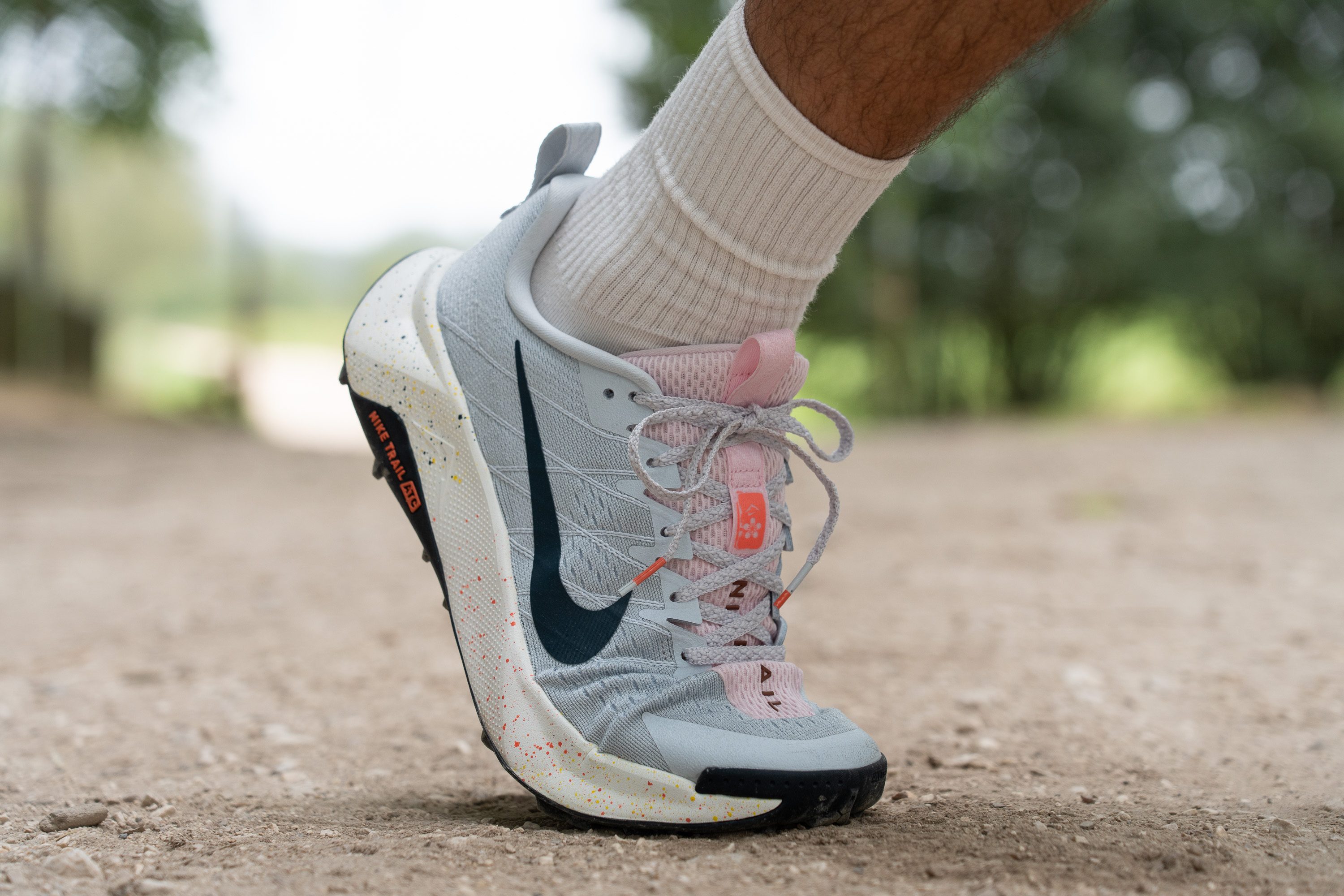
Still, the fit works well, with reinforced punched eyelets that feel durable. Tongue loops help keep everything centered, which is a nice touch.
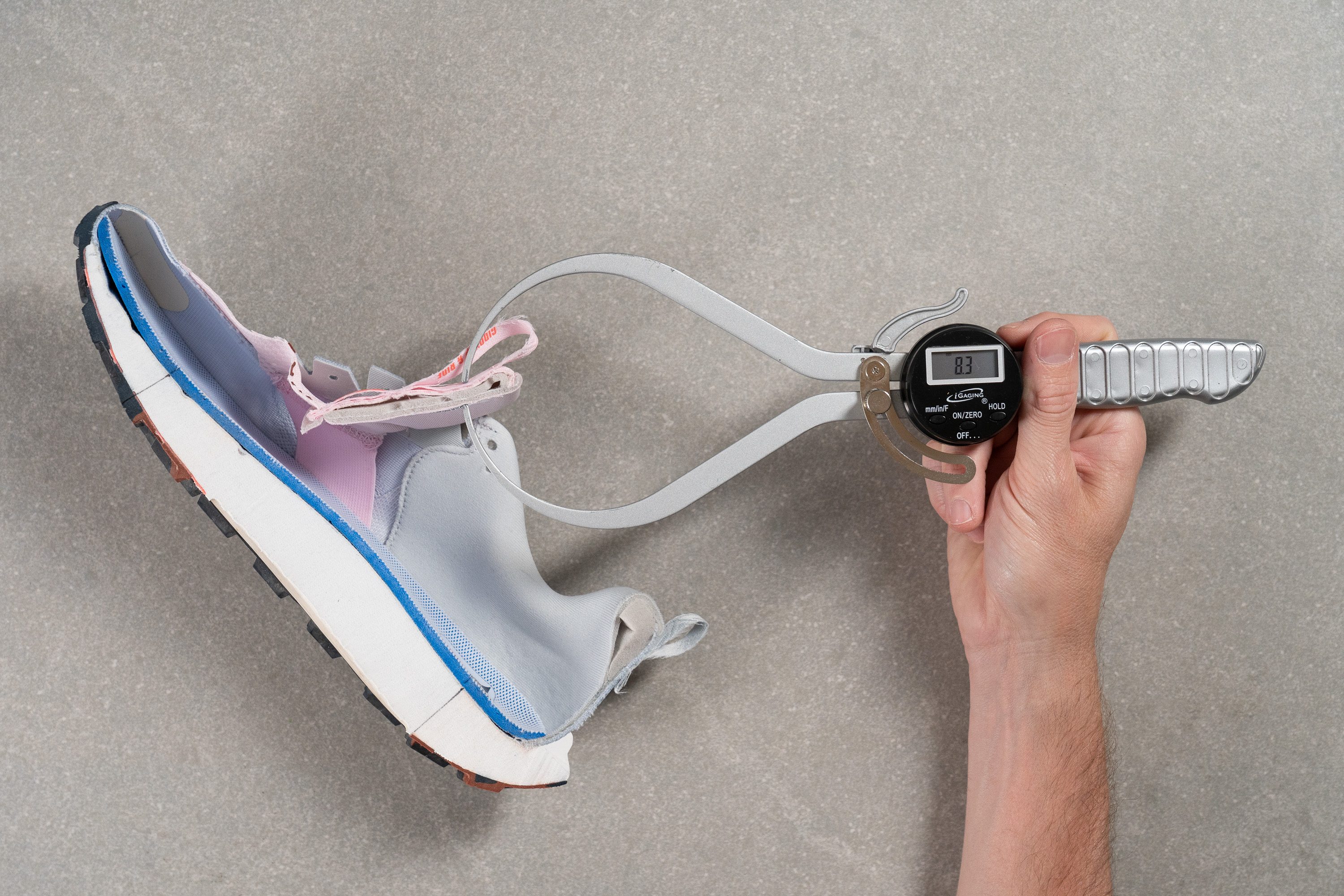
| Wildhorse 10 | 8.3 mm |
| Average | 6.4 mm |
Tongue: gusset type
The tongue is stitched to the sides, a feature some trail shoes are skipping, but we think it’s non-negotiable at this price point.
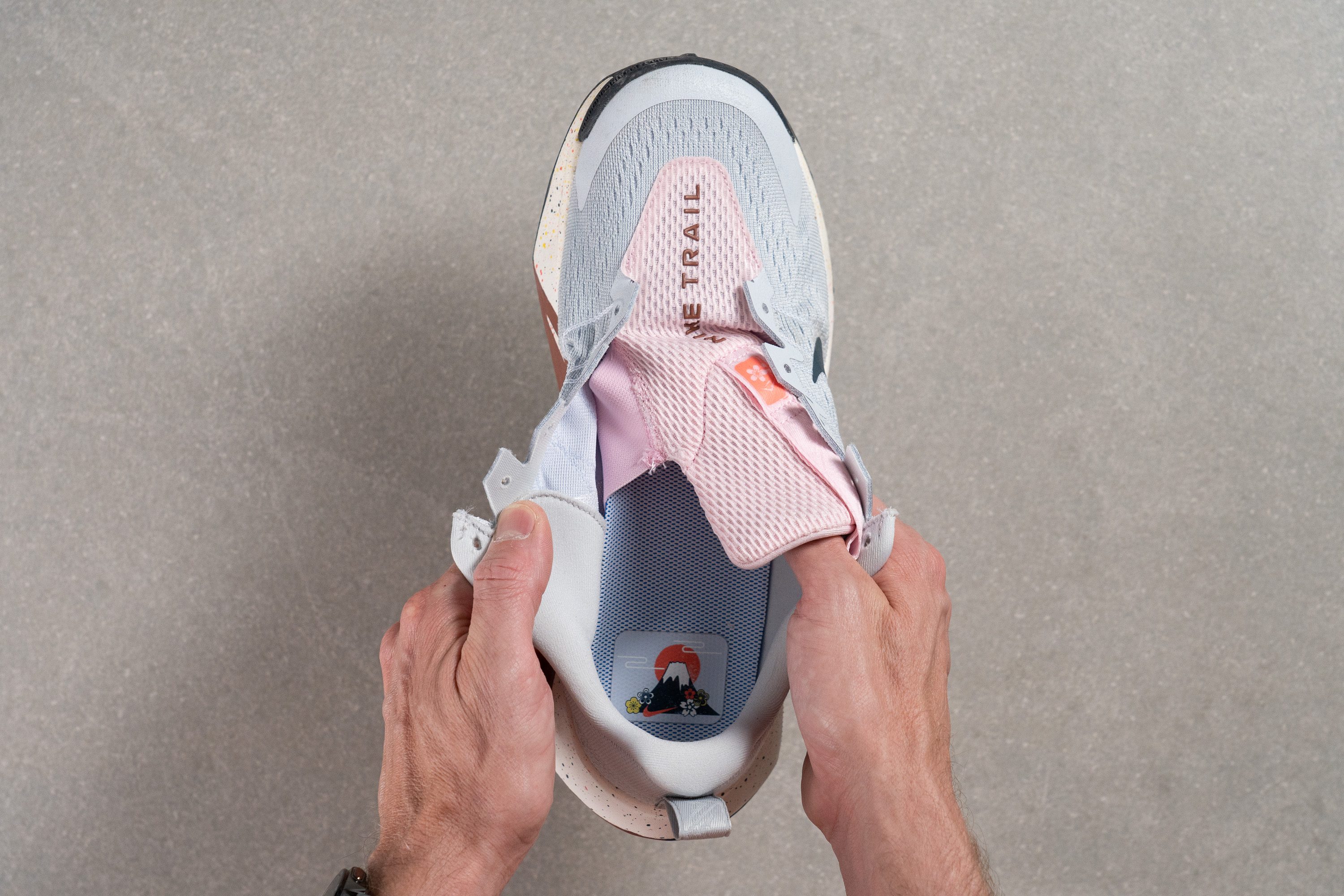
| Wildhorse 10 | Both sides (semi) |
Price
The price of the Wildhorse 10 is a step up from its predecessor, and there’s no way to sugarcoat it. Still, you’re getting more foam, upgraded materials, and added comfort. That might sound appealing, but if you're focused on price, this won't be the news you want to hear.
| Wildhorse 10 | $165 |
| Average | $153 |
Heel tab
The heel includes a finger-loop tab that not only looks great but also adds practical utility.
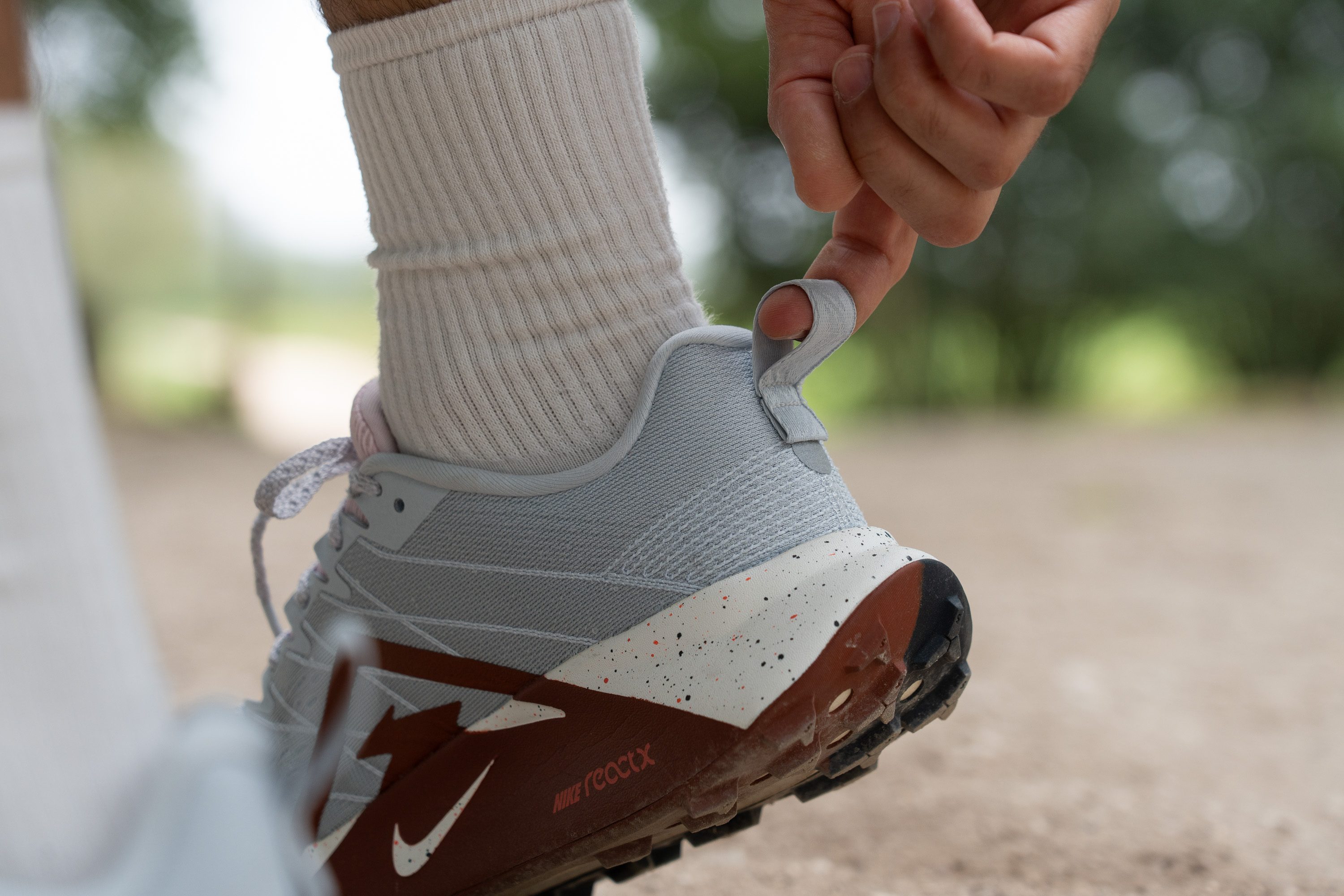
| Wildhorse 10 | Finger loop |

